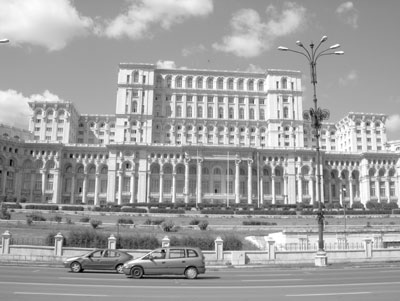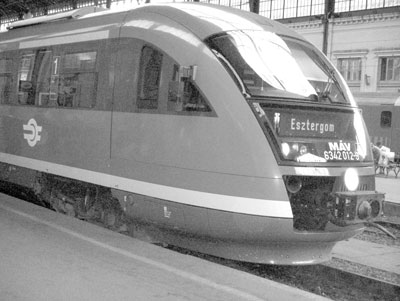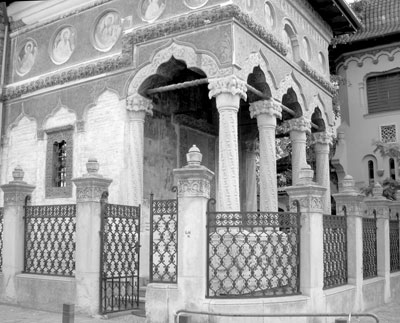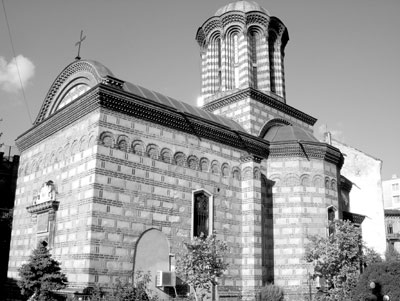Hungary & Romania Railpass
by Jay Brunhouse
Romanian Railroads (CFR) was a logical extension in 2004 to the stable of railroad companies accepting Eurail passes, but Hungarian Railroads (MÁV) was a surprise expansion of the Eurail system in 1985, and when it happened, I made a last-minute trip in time to add MÁV to the very first edition of my book “Adventuring on the Eurail Express.” Now a single 2-country pass covers unlimited travel on both.
The distance between the capital cities, Bucharest (Bucuresti), Romania, and Budapest, Hungary, is so great that the long EuroCity train consisting of first- and second-class carriages and a restaurant carriage departs Bucharest’s Nord Station at 6:30 a.m., when the sun is rising, and doesn’t straggle into Budapest’s Keleti Station until 13 hours and 47 minutes later at 7:17 p.m., in time for the sunset.
The more practical EuroNight Bucovina train carrying a restaurant carriage, second-class carriages, couchettes and sleeping carriages departs Nord at 6:50 p.m. Passengers alight in Keleti at 7:17 a.m. Reservations are required on both day and night through trains.
Desiro “Rapid” diesel trains supplied by Siemens to both MÁV and CFR sparkle. They have functional heating and air-conditioning. Although limited to 37 mph, they make getting city to city so simple that they are the primary means of transportation within Romania and Hungary.
Bucharest hub
Bucharest’s Nord Station is the hub of the CFR. Bucharest was once known as the “Paris of the East” because of the Parisian flare of its affluent citizenry. Under King Carol I, French as well as Romanian architects created Belle Époch palaces and public structures, an Arc de Triomphe and tree-lined Soseaua Kiseleff boulevard modeled after Paris’ Champs-Élysées. Bucharest was named a European Capital of Culture for 2007.
But Bucharest suffered mightily from the violence of the wartime puppet Fascist government, as one of the most oppressed and impoverished Communist countries and through a decade of half-hearted reform and economic mismanagement following the 1985 revolution when Mr. Ceaus¸escu was overthrown.
Bucharest’s best-known visitor attraction is the vast Palace of Parliament, the gigantic super-Stalinist stone-and-marble edifice. Under the Ceaus¸escu regime during the 1980s, workers demolished an entire district of picturesque old buildings and built what is, after the Pentagon, the world’s second-largest building. The palace covers 3,550,000 square feet on six levels and has 6,000 rooms in 21 separate wings. Its decorated interiors are a tourist magnet.
As well as housing the Romanian parliament, the building is also the venue of cultural events and many international conferences, such as the largest-ever April 2008 NATO summit that attracted George Bush and his 1,500 U.S. delegates.
Bucharest offers more to see. A Roman Orthodox church or remnants of a monastery seems to occupy every corner. Lipscani Street in the Old City area is a treasure. It was the most important commercial center of Bucharest in the Middle Ages. All trades were found there, including goldsmiths, hatters, shoemakers, tanners and saddle makers. Many streets still bear the names of the crafts.
Nearby, the 1545-1547 Curtea Veche (Old Court) and its church is an example of feudal-era religious architecture and the oldest in Bucharest preserved in its original form.
Blue Arrow to Brasov
Many Romanians rave about the Blue Arrow Siemens’ Desiro being evidence that Romania (and the CFR) has entered the 21st century. The Blue Arrow to Brasov, Romania’s second-most-important city, takes two hours and 54 minutes. Reservations are required.
Teutonic knights founded Brasov, in Transylvania, in 1211. Saxons from the Rhine and Mosel regions of present Germany settled there and set about building medieval walls, towers and churches so that the city still has a Germanic flavor.
Street signs are in both German and Romanian. Brasov’s historical attractions include the attractive, central Council Square, the beautiful Saint Nicholas Church and the Black Church that received its name because its walls were darkened by the fire of 1689. It is the largest Gothic church east of Vienna.
Transylvania is best known for the legend of Count Dracula. Fortified, medieval Bran Castle, built 16 miles southwest of Brasov by the citizens of Brasov in 1377, is usually known as Dracula’s Castle. Visitors entering the gate first encounter vendors selling Count Dracula dolls and amusing souvenirs.
Sighis¸oara is another of the Saxons’ Transylvanian Siebenburgen (Seven Castles). Built between the 12th and 17th centuries, it is the best-preserved citadel in Eastern Europe and is included in the UNESCO World Heritage Site list.
The castle’s defensive system is still preserved as are the nine towers of the guilds. The 200-foot Clock Tower has a Swiss mechanism and seven mechanical wooden figures that indicate the days of the week.
Near the Clock Tower is the “birth house” of Dracula, now a restaurant with a fortuneteller.
Beautiful Budapest
Budapest is known not only as one of Europe’s most beautiful capital cities because of its castle quarter, splendid parliament buildings and Danube River panoramas but additionally as a preeminent spa city.
The Gellért Bath is the most famous among all baths in Budapest for its architectural beauty. The fountains are over 200 years old. The bath itself was built in 1918 in Art Nouveau style. But it is also the priciest of its kind.
The joyous Széchenyi Thermal Bath is one of the largest spa complexes in Europe. It was built in 1913 next to the City Park. The reconstruction of the pools of the swimming section and their circulation devices was completed in 1999.
The so-called fancy bath includes a whirling corridor, underwater bubble jets, neck showers and back massage water-beams, so there is aqua fun for young and old, even when it snows and vapors rise from the thermal spa.
The ambience of Széchenyi’s structure is also admirable. The street-facing exterior is somber gray stone, with classical columns, but the semicircle of pool-facing architecture is bright canary yellow and features gingerbread Victorian latticework.
Local trains
The red MÁV Desiro “Rapid” trains to Esztergom depart hourly from Budapest’s Nyugati Station and take just one hour, 29 minutes to cross the Danube, tunnel through the Pilas Mountains and pass former Russian military buildings that are now a university campus.
In Esztergom, “The Cradle of Hungary” on the Danube River border with Slovakia, worshipers visit Hungary’s largest cathedral on István tér. It is Hungary’s ecclesiastical center and seat of the Roman Catholic Archbishop.
Keleti (East Train Station) is a tremendous 19th-century structure. Statues of George Stephenson, inventor of the locomotive, and James Watt, creator of the steam engine, grace the façade of the eclectic, charming exterior.
Nyugati (West train station) was designed and built by the French Eiffel company. Nyugati is handsome with its Victorian red- and brown-brick façade and blue-gray latticework. McDonald’s restaurant in Nyugati’s refurbished restaurant building was voted the world’s best McDonald’s for recalling Belle Époque railroading with shining period furnishings.
Many thanks
I thank Delta Air Lines (800/241-4141, www.delta.com) for their nonstop flights from New York’s JFK airport to Bucharest and from Budapest; Eurail G.I.C. (www. eurail.com) for all arrangements; the Hungarian National Tourist Office (New York, NY; 212/695-1221, www.gotohungary.com), and the Romanian National Tourist Office (New York, NY; 212/245-8484, www.romaniantourism.com). The arrangements by Cultural Romtour (phone +40 [0] 21 320 04 35, www. culturalromtour.com) made touring Romania wonderful.
In Bucharest, our group of journalists stayed at the historic Hilton Athénée Palace (phone 40-21-303-3777, www.hilton.com), with rates from €275 ($432). In Brasov we stayed at the Aro Palace hotel (phone 40-0268-477664, www.aro-palace.ro). In Budapest we occupied Hotel Lánchid 19 (phone +36 1 419-1900, www.lanchid19hotel.hu/en), which charges €131 ($206) per night.
The Hungary & Romania Railpass is available for five, six, eight or 10 days’ travel within two months and ranges in price from $193 for youth second up to $407 for first class.




